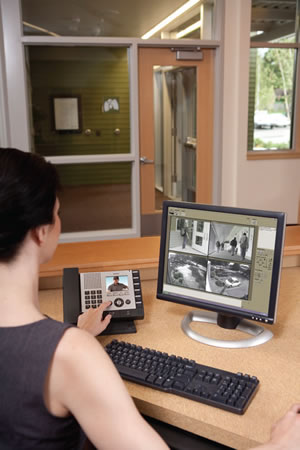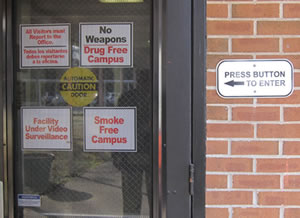Maintaining a Secure Environment
- By Patrick V. Fiel, Sr.
- 12/01/14

PHOTOS COURTESY OF AIPHONE
Active shooters, registered sex offenders, thieves, vandals and non-custodial parents often enter a K-12 campus through the front door. And it’s surprising how many campuses still allow them to do so without being directed into a pre-defined entry procedure that helps protect students, staff and school property.
Security-conscious schools across the country are taking control of front door access through specific policies and procedures that employ some of the most cost-effective layers of security equipment on the market. Once the front door is secure, the same planning and equipment can help to effectively control access to other school entries.
It’s a generally simple plan that involves locking all doors and keeping them locked throughout the day, especially whenever students are on campus. Then it’s a matter of approving visitors before granting them access.
While the concept behind controlling campus entries is constant, each school is different — in size, age, design and type of construction. That makes it wise for a school to look first to a security consultant with years of campus experience to conduct a thorough risk assessment. The assessment will include the entire campus, surrounding neighborhood and traffic patterns. The assessor will pinpoint a school’s security strengths and its weaknesses and suggest the specific tools and solutions required to secure the entries.

PHOTOS COURTESY OF AIPHONE
Who’s there? A school office receptionist checks with the campus’ video intercom before remotely unlocking the door allowing visitors entry into the building. The image in the top left portion of her screen shows a student who is late for class using the school’s front door video intercom to gain access to the campus.
A good assessor will help a school or district to spend its money more wisely to create effective, efficient and affordable barriers to unwanted campus visitors.
Here is a look at some of the equipment, polices and procedures required to secure the campus and help protect students, faculty and staff.
Locks are the first barrier at all exterior doors. They need to be high quality, electronic locks — with pick guards — that are able to be remotely opened by office personnel once a visitor has been approved to enter.
Video intercoms serve as the campus’ doorbell, alerting staff to a visitor requesting entry into the school. Office personnel can remain safely behind locked doors while viewing and talking with a visitor.
A video intercom consists of a vandalresistant door unit that is mounted just outside the entry. Most units include a color camera, call button and a microphone and speaker for voice communication. Units connect to a master station with a high-resolution monitor that typically sits on a receptionist’s desk.
Once the person is approved for entry, the office staff presses a button on the master station that unlocks the door and allows the visitor to move to the next step, a check-in desk.
Entry vestibules, considered a best practice on many campuses, allow access to the office, yet create an additional barrier — one last locked door — between the visitor and classrooms. Creating a vestibule may require construction of a wall and door.
Visitor management systems are the next step and represent a significant upgrade over the self sign-in books many schools have used for years. Visitors should be required to present a government-issued photo ID that is swiped through the system. Within seconds, the person’s name is checked against federal and state criminal databases and the national sex offender registry. Schools can also enter local data regarding non-custodial parents or disgruntled former employees that may not approved for contact with students. Approved visitors receive a temporary photo ID badge to be worn at all times while on campus. After receiving the badge, the door to the classrooms can be remotely opened.
The entire process beginning with the video intercom shouldn’t take a visitor more than a minute or two to complete. Parents, vendors and volunteers quickly get used to the process and come to appreciate the added security it provides students. There are a several other low-cost steps schools can take to protect the entry, including:
CPTED (Crime Prevention Through Environmental Design). Overgrown trees and bushes can block the view of the school as police patrol the area. The foliage can also provide a hiding place for weapons, contraband and people seeking to piggyback into the school with an approved visitor. Bright lighting helps identify people approaching the school on a dark winter afternoon and also is a deterrent to vandals and other criminals at night. Fencing and gates can control pedestrian traffic patterns and funnel visitors to the main entry for campus access.
Security screens protect glass doors and windows at the entry. Gunmen have shot through locked glass doors to access a campus — that’s how the Sandy Hook Elementary shooter got into the Connecticut school in December 2012. Guns, knives, clubs or rocks have little impact on the stainless steel mesh security screens.

PHOTOS COURTESY OF AIPHONE
Point the Way. Signage is inexpensive, but makes it clear what’s expected of visitors as they enter the campus. Starting in the parking lot, signs should direct visitors to the main entry and the video intercom. A sign (in multiple languages, if necessary) with instructions for using the system is helpful.
Signage is inexpensive, but makes it clear what’s expected of visitors as they enter the campus. Starting in the parking lot, signs should direct visitors to the main entry and the video intercom. A sign (in multiple languages, if necessary) with instructions for using the system is helpful.
Here are some other simple layers of security that can help at entry points and throughout the campus in general.
- Visitor intercoms can also be used on other doors such as faculty entries (teachers can forget their access cards or keys) and loading docks that receive vendors throughout the day. These extra units can be tied into the same master station, allowing centralized control of all entry requests.
- An audio intercom allows office personnel to simultaneously alert each classroom and provide specific commands such as lock in place or evacuate to a safer location. Or if the emergency affects a single classroom, such as an agitated non-custodial parent seeking his or her child, the notice can be shared only with that student’s teacher.
- Keypads or a simple cardkey lock can help protect faculty and staff entries, provide an audit trail of who has accessed a door and eliminate the need for traditional keys that are easy to lose, steal or be copied. Rekeying locks is an expensive and time-consuming event.
- Every classroom needs to be locked with doors that can be opened only from the inside. And with a $10 peephole added, teachers can see who wants entry without having to open the door.
- Panic buttons, concealed throughout the campus or, better yet, in the form of pendants worn by teachers, can immediately reach a student resource officer or other first responders in case of an emergency.
- Background checks of volunteers and vendors are now affordable while offering an added layer of protection against known criminals and sex offenders.
- And here’s a cost-free idea; park the campus SRO’s vehicle in front of the school where it will be visible to all visitors and street traffic. This can be a powerful deterrent to criminals.
Of course, surveillance cameras — although more expensive than any of the previous tools — are an excellent deterrent at the entry. And if placed outside throughout the campus and in hallways, stairwells, locker areas and the cafeteria they can provide real-time and recorded images during an emergency and after. Images can also be shared with first responders.
But always keep in mind that while each of these solutions have been proven in use on many campuses, they can still fail without proper policies and procedures for school employees to follow. Office personnel must have clear guidelines about who can enter the school. Teachers and staff need to understand they can’t prop open doors while making a quick run to their cars. A campus adult should challenge all unknown and unbadged visitors. Anything that seems out of the ordinary should be reported immediately to a campus administrator or the SRO. Put these policies and procedures in writing for all employees and then practice them through regular drills.
Also engage parents so they understand the security goals. And work closely with local first responders so they know what tools and procedures are in place to help protect the campus during an emergency.
It’s no longer reasonable to postpone taking action to protect students citing budgetary concerns. The systems outlined here are affordable. They are easy to install and operate. And they are very effective. These systems provide multiple layers of security between potentially dangerous visitors and children on campus. They also help to protect property from theft and vandalism.
Hardening the campus entry is a best practice advocated by top security professionals. It’s a concept that can work on virtually any school and provides a high degree of security for a relatively limited investment.
This article originally appeared in the issue of .